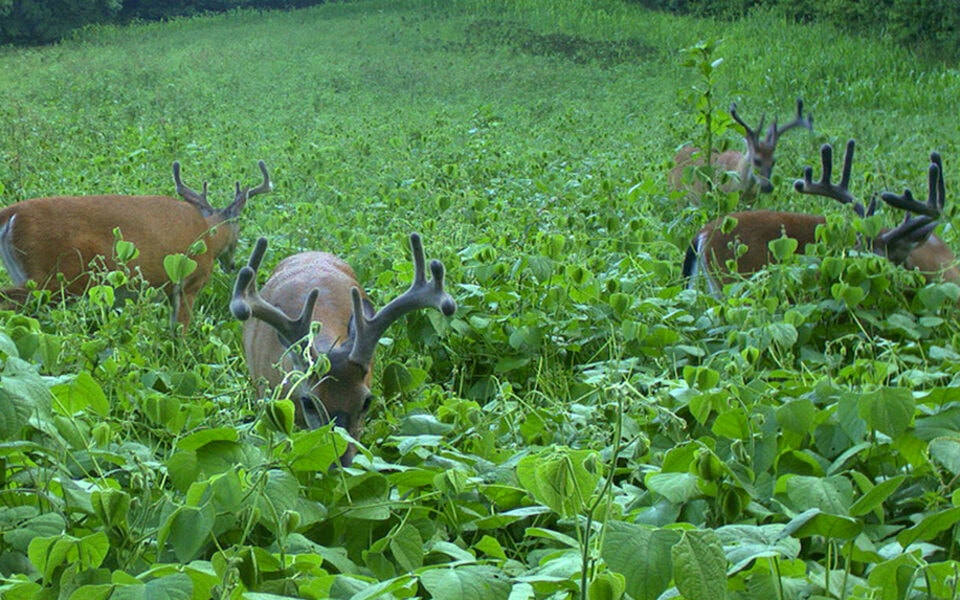With the flood of informational articles and video material on food plots coming out in recent years, it would seem everything about the subject has been said. Maybe that’s part of the problem, too much information, and not all of it totally accurate. Articles, TV shows, DVDs, podcasts, blogs, books…so much material has been published, broadcasted, or uploaded that it can be intimidating to wade through it for some-one just trying to get into growing food plots.
Much of what’s been written makes you wonder if you need to be a trained agronomist with a PhD in agriculture just to grow a few plots for deer and other wildlife. Other articles insist you need a $90,000 tractor and a minimum of a thousand acres to make it worthwhile.
Other pieces address the subject dismissively, taking a negative slant and badmouthing plots as “not worth creating” because “they don’t really help wildlife”…right. And if the plots do grow crops, mature bucks won’t use them, or they’ll soon be overtaken by weeds, or they won’t work because farm crops are readily available on surrounding lands.
All of these detraction’s when added one after another may discourage many young hunters and landowners with small properties, modest financial assets, or only a small amount of time from getting into this activity. I say that’s all nonsense, where there’s a will, there’s a way and every little bit you accomplish adds to the whole – so even small properties or managers with a tight budget can make a difference.
This article will attempt to go through some of these common, but erroneous beliefs and set the record straight. Even old timers with dirt under their fingernails may find some of these “myths” and my rebuttals thought provoking and interesting to read. We gathered up a long list of misleading ideas, but settled on twelve of the most common ones ripe for debunking.
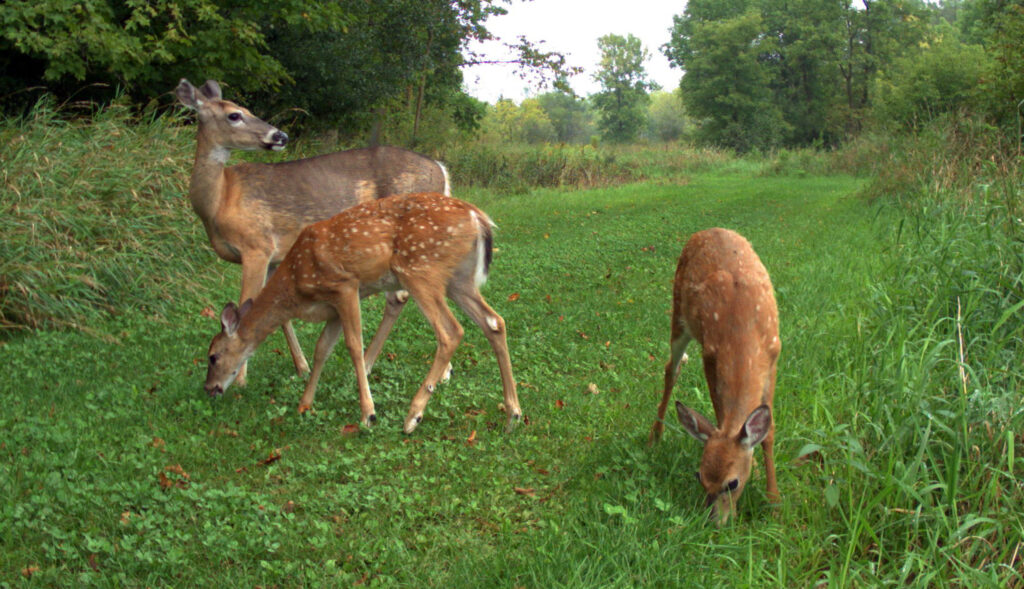
Dave Medvecky
Food Plot Myth #1: Food plots are expensive
This probably keeps many “would-be” food plotters from getting started growing crops for wildlife. After all, we have to pay for a nice rifle, optics, GPS, trail cameras, bow, crossbow, ammo, the latest hunting clothes, and $200 boots. Then we need to pay lease fees or mortgage payments and taxes on land we purchased, hunting club memberships, etc. etc.
Hello? Tally up those things and it’s actually scary how much we spend as passionate hunters and land stewards. Compared to those, the costs of a small used tractor, a couple of implements, lime, fertilizer, seeds, and herbicide are really modest. The tractor would be the biggest expense, but you may be able to borrow, rent, or cost-share one with a few buddies. And many high quality food plots are created with just an ATV or UTV, which most hunters have, knocking out this major expense for growing food plots.
Seed costs tend to be way down the expense list with the typical food-plotter, since it only costs perhaps a few hundred dollars, or less each year on seeds to grow a variety of quality crops. You probably spend that on arrows and ammo.
Food Plot Myth #2: It takes lots of free time
Wrong again – chances are, if any really heavy lifting work like bulldozing a clearing in the woods is called for you’ll hire the job out to a professional. Most food plotters, fortunately, usually have easier places where they can start such as a fallow or unused field or log landing in the woods. In these cases you simply have to kill the weeds, remove the residue, till the ground, plant seed and fertilize. Those can all be done in staggered steps if your schedule is tight and you only have a half day here, or weekend off there – or even for the absentee land owner.
Simply categorize the steps you need to take to create the plot and work the few hours required for each procedure to be completed. If you live far away from the land involved, plan a free weekend ahead and get several of the chores done. If necessary, delegate some tasks to a neighbor farmer or retiree up the road looking for something to do such as tilling the ground or spraying Roundup when he’s planning to treat some of his own fields. The same goes for mowing, if you can’t get free when weeds are ready to go to seed and the clover is starting to flower, get some help.
Food Plot Myth #3: Preparing a Site Takes Heavy Equipment
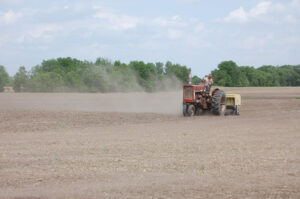 The truth is; many plots can be prepared with an ATV and a few implements, or one multipurpose unit such as a Firminator. Mini-plots on a buck’s travel route from bedding cover to major feeding areas can be created with simple hand tools or a garden tiller. When initially breaking sod, you may want something a bit heavier, but from that point on, with 15 acres or less you can handle it with an ATV. Renting a 40-plus horsepower tractor and tiller/disk for a weekend is a relatively easy way to initially break sod.
The truth is; many plots can be prepared with an ATV and a few implements, or one multipurpose unit such as a Firminator. Mini-plots on a buck’s travel route from bedding cover to major feeding areas can be created with simple hand tools or a garden tiller. When initially breaking sod, you may want something a bit heavier, but from that point on, with 15 acres or less you can handle it with an ATV. Renting a 40-plus horsepower tractor and tiller/disk for a weekend is a relatively easy way to initially break sod.
Will these be as productive or attractive as one made with a tractor? Maybe, but they’ll still get the job done, causing a traveling buck to pause within bow range to munch on the treat as he heads for larger fields.
If finances allow, a small to medium tractor is certainly the best bet of all, coupled with a tiller or disk, mower or rotary cutter, and sprayer, plus some way to spread your seed and fertilizer. Buy used and you can get this set of equipment for $6,000 to $15,000, new it would cost $20,000 to $50,000. That being said, these investments will likely last you for a lifetime with proper care and maintenance.
Food Plot Myth #4: Plots aren’t needed if you have good native habitat
Natural foods growing on a property are a very important ingredient for a thriving wildlife population. Forbs, weeds, shrubs, leaves, along with soft and hard mast will make up much of a whitetail’s diet no matter how many food plots you create. However, native vegetation cannot compete with food plots when it comes to providing lots of high quality food.
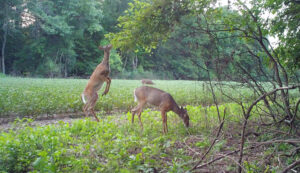
Dave Medvecky
If the natural habitat is high in quality, one of our initial jobs as gamekeepers should be to protect and improve what’s there. Enhancing the native habitat can be a project that really doesn’t break the bank. Much can be done with a chainsaw, a couple gallons of gas, some herbicide, a mower and maybe a little fertilizer. Enhancing native food sources will help to shrink your food plot budget.
As important as they are; wild, native foods rarely have the protein content of a food plot, usually averaging out to around 7 to 11 percent. Now consider that a whitetail needs 16 to 21% protein, depending on the time of year. While most managers know that whitetail antlers are made up of the “bone growing ingredients” of calcium and phosphorus (antlers are 22% calcium and about 11% phosphorus), but get this…they are 45% protein! While certain browse species can have high protein levels in certain stages of their growth, on average, native vegetation will only churn out about 8 to 9% protein. At times of the year, during fawn rearing or antler growth in particular, they require more than 16% protein.
Food plots such as lablab, brassicas, clovers, Deer Radish, and cereal grains all provide more protein than that, typically 20 to 40 percent, balancing out the lower-protein of the native forage. But native sources are still vital.
Even if the added protein wasn’t needed, from a management standpoint, it’s important to draw deer in with these “magnets.” If you want to create a more balanced sex ratio and age structure, attracting deer with plots allows you to manage them properly—something the surrounding neighbors may not want to do. Drawing in deer to our properties and keeping the ones already there satisfied, is a goal of most gamekeepers. This way a buck may be allowed to attain an age that a particular gamekeeper deems “mature” before they’re harvested. It will also make it easier to keep the number of does in balance with the habitat.
Food Plot Myth #5: Weeds will quickly overtake your food plot
 The battle with weeds is one of the toughest that beginning food plotters face, and even many veterans. But with proper steps, this battle can be won, in fact, even made easy.
The battle with weeds is one of the toughest that beginning food plotters face, and even many veterans. But with proper steps, this battle can be won, in fact, even made easy.
First, the existing vegetation needs to be killed before the plot is put in with a non-selective herbicide such as Roundup. Follow that up with a well-timed spraying with selective herbicides when problem grasses emerge. As the plot grows, you may need to follow up with mowing after the weeds that weren’t targeted by the selective herbicide grow taller than the planted crop, but before they seed out and repopulate.
Note that we didn’t say weeds can be eliminated. That’s almost impossible. But other than aesthetics, a plot with some native weed and forb growth can in many cases attract deer more than a neatly-manicured, nearly weed free plot. Perhaps it’s the variety of forage available in the weedy plot with some forbs that the deer especially like, or maybe it’s the more natural appearance, but deer definitely won’t ignore your plot because of a few weeds. Control them, yes, so they don’t dominate the plot. But don’t obsess over killing every weed. You’ll just drive yourself crazy.
Food Plot Myth #6: If you’re surrounded by farm fields, food plots won’t draw deer in.
The fact is; you can out-draw most agricultural fields 9 days out of 10 if you have the right crops planted. Corn, which most farmers grow, is poor quality forage for deer during much of its growing season. And once it matures, farmers harvest it using modern sophisticated equipment that leaves little waste grain.
Soybeans, the other major crop grown, offer better forage during summer with their high protein green leaves, but once they turn yellow they become unattractive. And soon after that, they’re harvested, again leaving few leftovers.
In contrast, lush green cowpeas, clover, alfalfa, radish, or brassica plots will attract deer starting from the time they emerge from the ground. That’s true even if the animals do dine in some on the surrounding crop fields, because they like the variety in their diet and the food plot crops typically offer more digestible, quality forage, in many cases modified specifically for a whitetails’ digestive system.
Even more importantly, your food plot and surrounding habitat offers more security and cover than the big agricultural operations with their “clean farming” approach which leaves little “edge” – few scruffy borders, hedgerows, thickets and other types of cover that make a mature buck feel safe and secure. That alone can make them choose your plots over the big, open farm fields.
Food Plot Myth #7: They only attract does and young bucks during daylight.
This can certainly be a problem with many food plots if they are located in spots that weren’t chosen carefully and don’t offer sufficient cover either on a big buck’s approach route to them or as he enters the field. It can also be a problem if you put too much pressure on a spot. You can overcome this by locating some of your plots closer to bedding cover (small “kill” plots) along a buck’s likely travel corridor to larger evening and night feed areas. And use a little common sense and don’t over hunt the area.
Savvy food plotters also often add cover along these travel routes towards the plot with techniques such as hinge cutting low-value trees and planting Egyptian wheat, Blindspot, hybrid Sudanese sorghum, or native warm season grasses.
So yes, some plots in certain locations may mostly draw in does and young bucks during daylight, but those are still valuable as mainly nutrition plots. And with a bit of work, you can create a “feeling of security” around your plots that WILL draw in mature bucks during legal shooting hours.
Food Plot Myth #8: You need a lot of land and large plots to attract deer.
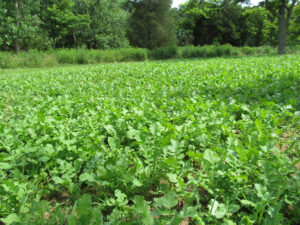 Any land manager with even a smidgen of experience under their belt knows this one is false. In fact, some of the best plots are small, remote plantings placed along a buck’s afternoon travel corridor from bedding to feeding. You can create these with little disturbance and waylay bucks on their way to major larger evening feed areas which may or may not be on your land. Mature bucks in particular are more likely to use these secluded smaller plots.
Any land manager with even a smidgen of experience under their belt knows this one is false. In fact, some of the best plots are small, remote plantings placed along a buck’s afternoon travel corridor from bedding to feeding. You can create these with little disturbance and waylay bucks on their way to major larger evening feed areas which may or may not be on your land. Mature bucks in particular are more likely to use these secluded smaller plots.
And the key word in this myth is “attract.” You may not hold your target deer on your land year-round, but with a small parcel of land in a strategically good area with small, but nutritious and palatable plots can indeed ATTRACT deer. And that’s all you really need to harvest them.
Food Plot Myth #9: It takes rich, black bottomland soil to grow a good food plot.
Fortunately, this one’s not true at all or a lot of us would be out of luck. A number of food plot seeds and mixtures will do well in less-than-perfect soils. It may be dry, acidic, or rocky, but almost any bare ground can grow a food plot of some kind that will attract deer with enough lime, fertilizer and prep work.
Food Plot Myth #10: You can’t have food plots if all you own is wooded land.
This is a similar situation to the one above. They may not be perfect. But you can grow plots in woods. The key is to use specialized seed mixtures such as Hot Spot with plants like radishes, rye and buckwheat that can grow with a minimal amount of sunlight. Even brassicas can be grown with only 6 hours of direct sunlight per day.
You may also need to “daylight” some logging roads, skid trails, and landings. Just a bit of work along the borders can open the canopy to allow additional sunlight to hit the soil. That can help turn a “dark woods” into a “workable food plot location.” Don’t forget to do your soil test, though. Chances are these soils in the woods will need a good dose of lime and some fertilizer. But with those additions and a few hours of sunlight, many places in forested habitat will work very well for plots. And lush, green forage in those locations is so scarce; a plot there will draw deer like a magnet.
Food Plot Myth #11: A deer will grow the same rack whether it has plots available or not because of its genetics.
Countless gamekeepers have seen this myth proven very wrong. Clearly, rack size is determined not just by genetics, but also age and nutrition. We can’t change the local genetics, but we can allow deer to reach the age required to grow a good rack (most gamekeepers would consider an average buck at four, or better yet five years old to be a “shooter”). And we can greatly influence nutrition. On my small tract of land I’ve witnessed a steady improvement in average antler size for a given age class derived from habitat work and food plots.
Food Plot Myth #12: A deer’s body weight can’t be improved with plots.
This is also untrue – it is true that deer will tend to average a certain weight for their geographic location, but statistics prove that added and improved nutrition can boost average weight for every age class!
I saw this I when I participated in our state’s “Deer Management Assistance Program.” Yearling field-dressed buck weights in my area (which included some prime farm country) were about 85-90 pounds. After my food plot programs kicked in, one year old bucks were averaging around 100 pounds. Five year olds weighed in at 165 to 185 pounds field dressed. That topped the typical weights from properties without food plot programs by 20-25 pounds.
These are just a few of the many “myths” circulating about food plots. Hopefully dispelling these will keep some newcomers or those struggling to improve their plots motivated to double their efforts and press onward, unhampered by the naysayers who badmouth them or tell you they’re out of reach for the average hunter or small landowner.
Join our weekly newsletter or subscribe to GameKeepers Magazine.
Your source for information, equipment, know-how, deals, and discounts to help you get the most from every hard-earned moment in the field.

